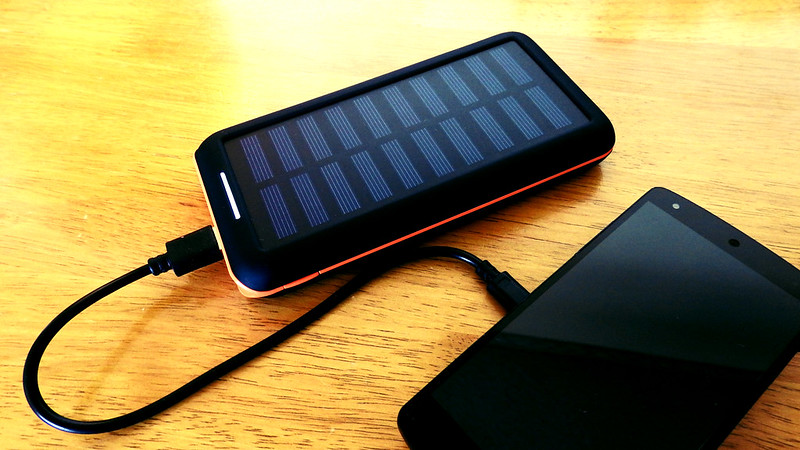When you are out in the wilderness, your smartphone is your lifeline. You can’t just call for help and hope that someone answers. You must have access to information, so you know how to get home or contact others if necessary. That’s why smartphone users need portable power banks and solar chargers. A portable power bank will give you more than just extra power for your phone.

It is also used to keep other small electronics charged, like cameras, tablets, and laptops. With a portable power bank, you also don’t need to keep charging your devices up once you are back at camp or in civilization again. There are two major types of portable power banks: external battery packs and internal battery packs.
Inner battery packs usually plug into a USB port on your device, while external battery packs connect via a cable. Generally have their dedicated ports or clips so they can be easily attached and removed from a backpack or purse without unplugging anything else.
What is a Solar Charger?
A solar charger is a device that harnesses the power of the sun to charge devices like smartphones, laptops, and cameras. They usually have panels that can fold up or be secured when not used or a stand that allows them to rest on a window or outside surface. You can get solar chargers that can charge a variety of devices and batteries as well, like your car’s lighter or your camping stove. Solar chargers are used in a variety of ways. For example, you can use a solar charger to keep your phone’s battery charged when you are not near a wall outlet or have access to a power bank. You can also use a solar charger to keep a device’s battery topped off during day trips or in remote locations where power isn’t readily available.
What is a Power Bank?
A power bank is a portable battery designed to be attached to another device so you can charge your phone, tablet, or camera. Some external battery packs can double as solar chargers, allowing you to get the most out of each one. Power banks usually have a few different charging ports, allowing you to charge various devices simultaneously. They typically come with a few extra charging cables so you can set them at home or while on the move. Unlike solar chargers, designed to charge devices during sunlight passively, power banks usually have a more powerful internal battery that can quickly assess your device. When setting a power bank, the time it takes to charge your device fully is usually shorter than if you were charging your device directly from an outlet.
Differences Between Solar Chargers and Power Banks
Now that you know the basics of each device let’s look at some of the key differences between solar chargers and power banks.
Differences in size between Solar Chargers vs. Power Banks
After thoroughly understanding both solar power banks and solar chargers, You might want to understand the differences between them. In the same way, we’ll first look at the size of the differences between solar chargers and power banks.
Beginning with solar chargers, even though the majority of them come with a folding design, the majority of solar chargers have to be opened when you plan to charge any device. Once opened, the majority of solar chargers are larger than laptops. Even though they have a capacity of 10000 mAh, many of these power banks can easily fit into your pocket or in your bag, which makes them a better choice for a portable solution.
Differences in Weight between Solar Chargers vs. Power Banks
Although having a smaller size aids in keeping your power bank in your bag, the situation is completely different when you’re using larger power banks, which are carried inside your bag. That’s why solar chargers are a great alternative, particularly if you have several high-capacity power banks within the power bank.
In addition, if you are planning to be away from your home for several days and nights, your batteries will cease to function when they are depleted of capacity for charging, which makes solar chargers an ideal option for those who want to carry them around in your backpack.
Differences in Price between Solar Chargers vs. Power Banks
Before you decide between solar chargers and power banks based on the information mentioned above, you should consider their price variations. If you don’t look at the price differences between solar chargers and power banks, you may not be capable of making the right decision for value-for-money. However, the cost differences are where things can get complex.
Although the cost of power banks will depend on their charge capacity, solar chargers come with different pricing based on power output. That’s why you will find that most of the major brands’ power banks range between $15 to $150. In terms of solar chargers, most of the major brands will provide solar chargers priced between $20 and $300. In contrast, solar chargers can appear to be more expensive but offer unlimited charges. Therefore, depending on your budget and usage, you can choose between these two options.
Related: How to Choose the Best Power Bank for Your Smartphone?
Why Should You Have Both a Solar Charger and Power Bank?
Although it might seem like you only need one type of portable power, there are many benefits to having both a solar charger and a portable power bank.
– Versatility – A solar charger can be used to charge a variety of devices, from your phone to your camera to your car lighter. On the other hand, a power bank can be used to set up a few different devices and as a backup battery.
– Long-Term Battery Backup – While solar chargers are used to charge devices when you are out in the wilderness, they won’t give you much power in an emergency. On the other hand, power banks can charge your phone, power your device when it’s low on battery, or serve as a backup for your devices in case of an emergency.
– Versatility of Portability – Both solar chargers and power banks can easily be carried around, making them easy to access when needed. A solar charger and power bank means you can simultaneously charge one device while keeping the other charge.
– Safety – Power banks and solar chargers are great for emergencies, but they can also help you save energy while out and about. This way, you won’t have to spend as much time waiting in line at a restaurant while your tablet gets a quick charge on your power bank and your phone gets an adequate amount of power on your solar charger.
Final Words
With all these advantages, you might wonder why you’d ever need to buy a solar charger and power bank. The obvious answer is versatility. Having both a solar charger and power bank means you can charge your devices near a wall outlet or outdoors, and you can also use them to charge your devices when you’re in a pinch.
Solar chargers and power banks are great for outdoor activities like camping, fishing, hiking, and emergencies. You should also consider getting one if you’re someone who travels a lot and wants to be able to charge their devices on the go.



